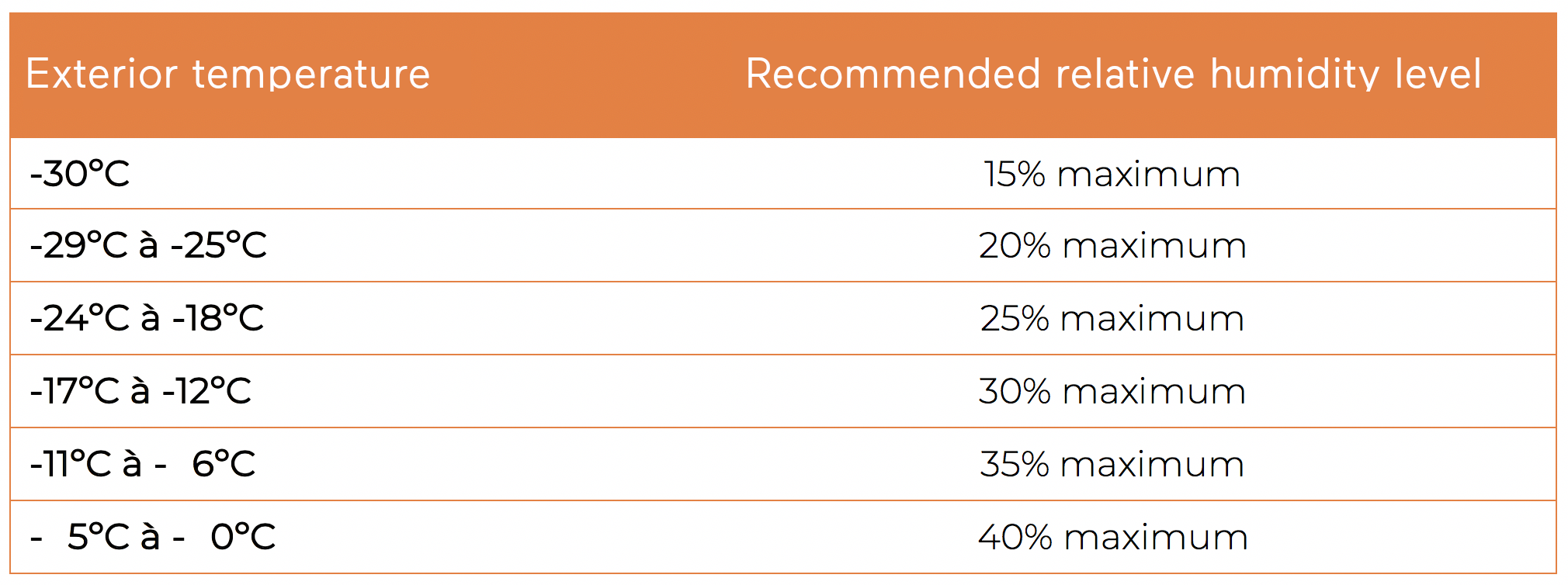UNDERSTANDING CONDENSATION IN 3 STEPS
1. WHAT IS CONDENSATION?
Several factors influence this phenomenon: indoor ambient temperature, the humidity level in the air, the temperature on the surface of the glass, the outside temperature, and the occupants’ habits.
Condensation occurs when the surface of your window is cold, and the moisture in the ambient air (inside your home) cools upon contact and condenses. The colder the surface, the more the fog turns into water droplets or even frost. It is understood that the higher the humidity level in the ambient air of your home and the colder the surface of the window, the more condensation there will be.
2. HOW TO PREVENT IT?
A good way to prevent condensation on your windows is to adjust the indoor humidity level of your home.
Simply reduce it according to the outside temperature as indicated in the table below (make sure the indoor humidity level does not exceed 50%). To facilitate this process, we recommend getting a good quality hygrometer. This tool measures the humidity level in your house.

Source : Canada Mortgage and Housing Corporation (CMHC)
Note : Maintaining a low humidity level for an extended period could have effects on the building or the health of your family members and yourself. It is possible to tolerate condensation during certain cold periods to counter these negative effects.
3. HOW TO REMEDY IT?
VYou can limit and manage activities that create humidity. Here are some examples:
This method will have limited consequences on your heating costs. In fact, a dry environment is much easier to heat than a humid home.
Several factors influence this phenomenon: indoor ambient temperature, the humidity level in the air, the temperature on the surface of the glass, the outside temperature, and the occupants’ habits.
Condensation occurs when the surface of your window is cold, and the moisture in the ambient air (inside your home) cools upon contact and condenses. The colder the surface, the more the fog turns into water droplets or even frost. It is understood that the higher the humidity level in the ambient air of your home and the colder the surface of the window, the more condensation there will be.
2. HOW TO PREVENT IT?
A good way to prevent condensation on your windows is to adjust the indoor humidity level of your home.
Simply reduce it according to the outside temperature as indicated in the table below (make sure the indoor humidity level does not exceed 50%). To facilitate this process, we recommend getting a good quality hygrometer. This tool measures the humidity level in your house.

Source : Canada Mortgage and Housing Corporation (CMHC)
Note : Maintaining a low humidity level for an extended period could have effects on the building or the health of your family members and yourself. It is possible to tolerate condensation during certain cold periods to counter these negative effects.
3. HOW TO REMEDY IT?
VYou can limit and manage activities that create humidity. Here are some examples:
- Get an air exchanger with a heat recovery system or a dehumidifier.
- Check the humidity level in the basement with your hygrometer (it influences the whole house).
- Use the kitchen exhaust fan when cooking.
- Use the bathroom exhaust fan when taking a shower or bath and try to reduce the duration of your sessions.
- Allow air to circulate freely near your windows, so avoid completely closing your blinds and curtains (especially at night).
- If you have an indoor fireplace, store your firewood outside the house.
- Make sure the dryer vent is properly attached to the air duct (this will prevent an increase in humidity).
This method will have limited consequences on your heating costs. In fact, a dry environment is much easier to heat than a humid home.
Return to the articles page

 Find a distributor
Find a distributor











